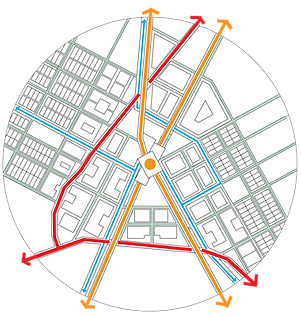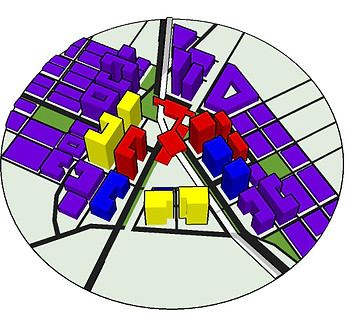Temporal Diffusion Plane
Fall 2017 | Light and Sustainable Design | Prof. Matt Fajkus
Three and a half stories residential building for a family of three members was designed and constructed at Kathmandu, Nepal. Rcc structure with ground and first floor as a rentable space were conceptualized taking solar exposure into considerable. Kathmandu with a monsoon climate has four different seasons: Winter, Summer, Rainy, and Spring. So the building is designed in such a way that it has the highest solar exposure during winter while during summer the building is well shaded. Moreover, shading from the rain is also taken into consideration. The architecture style of the Kathmandu valley is studied and the building is conceptualized which shows respect towards the surrounding contemporary style.
Three and a half stories residential building for a family of three members was designed and constructed at Kathmandu, Nepal. Rcc structure with ground and first floor as a rentable space were conceptualized taking solar exposure into considerable. Kathmandu with a monsoon climate has four different seasons: Winter, Summer, Rainy, and Spring. So the building is designed in such a way that it has the highest solar exposure during winter while during summer the building is well shaded. Moreover, shading from the rain is also taken into consideration. The architecture style of the Kathmandu valley is studied and the building is conceptualized which shows respect towards the surrounding contemporary style.
Three and a half stories residential building for a family of three members was designed and constructed at Kathmandu, Nepal. Rcc structure with ground and first floor as a rentable space were conceptualized taking solar exposure into considerable. Kathmandu with a monsoon climate has four different seasons: Winter, Summer, Rainy, and Spring. So the building is designed in such a way that it has the highest solar exposure during winter while during summer the building is well shaded. Moreover, shading from the rain is also taken into consideration. The architecture style of the Kathmandu valley is studied and the building is conceptualized which shows respect towards the surrounding contemporary style.
Temporal Diffusion Plane
Fall 2017 | Light and Sustainable Design | Prof. Matt Fajkus
Project partners: Rob Manion, Elijah Montez, Shani Saul
Temporal Diffusion Plane
Fall 2017 | Light and Sustainable Design | Prof. Matt Fajkus
Project partners: Rob Manion, Elijah Montez, Shani Saul
Perforations on the building envelope are designed to reflect the changing seasons and subsequently the changing quality and angle of natural light. Made of Ductal high-performance concrete the façade is either fully open to allow full light into space or punctured in a pattern that creates an interesting and dynamic light that moves as time passes.
Light historically has governed our days. Long before the existence of “artificial” light, the sun was the driving force behind all human activity. Today, daylight affords numerous biological, emotional, and perceptual advantages to the human body that are unmatched by artificial lighting mechanisms. Architecturally, natural light has the ability to connect us with the present moment and encourage an increased awareness of our environment. It reminds us of the passage of time by infusing the material world with that of the ephemeral, and in doing so, harmonizes the user with the natural world. As light is redefined through the passage of time, the experiential quality and use of its respective spaces shifts as well. A sustainable built environment will focus on harvesting and honoring the ephemeral quality of natural light to reengage the human body and mind.
Perforations on the building envelope are designed to reflect the changing seasons and subsequently the changing quality and angle of natural light. Made of Ductal high-performance concrete the façade is either fully open to allow full light into space or punctured in a pattern that creates an interesting and dynamic light that moves as time passes.
Light historically has governed our days. Long before the existence of “artificial” light, the sun was the driving force behind all human activity. Today, daylight affords numerous biological, emotional, and perceptual advantages to the human body that are unmatched by artificial lighting mechanisms. Architecturally, natural light has the ability to connect us with the present moment and encourage an increased awareness of our environment. It reminds us of the passage of time by infusing the material world with that of the ephemeral, and in doing so, harmonizes the user with the natural world. As light is redefined through the passage of time, the experiential quality and use of its respective spaces shifts as well. A sustainable built environment will focus on harvesting and honoring the ephemeral quality of natural light to reengage the human body and mind.
Mandir
2016 | Volunteering Work
Mandir
2016 | Volunteering Work
Robinson Ranch Station
Spring 2018 | Transit Oriented Development | UTSOA | Prof. Ming Zhang
Project Partner: Sagnika Das, Olivia Posner, and Emma Patton
Imagine Austin's growth map foresees 'Robinson Ranch Station' as one of three regional centers in Northwest Austin. The intersection of Austin's red line and the Union Pacific Railroad provides an opportunity for a future transit hub including high-speed rail. The Robinson Ranch development is connected to the local community, and the area around the station is a place for residents to live, work, and play. The high density near the station accommodates future employees who will work in Austin's Downtown 2.0.


%20(1).png)



